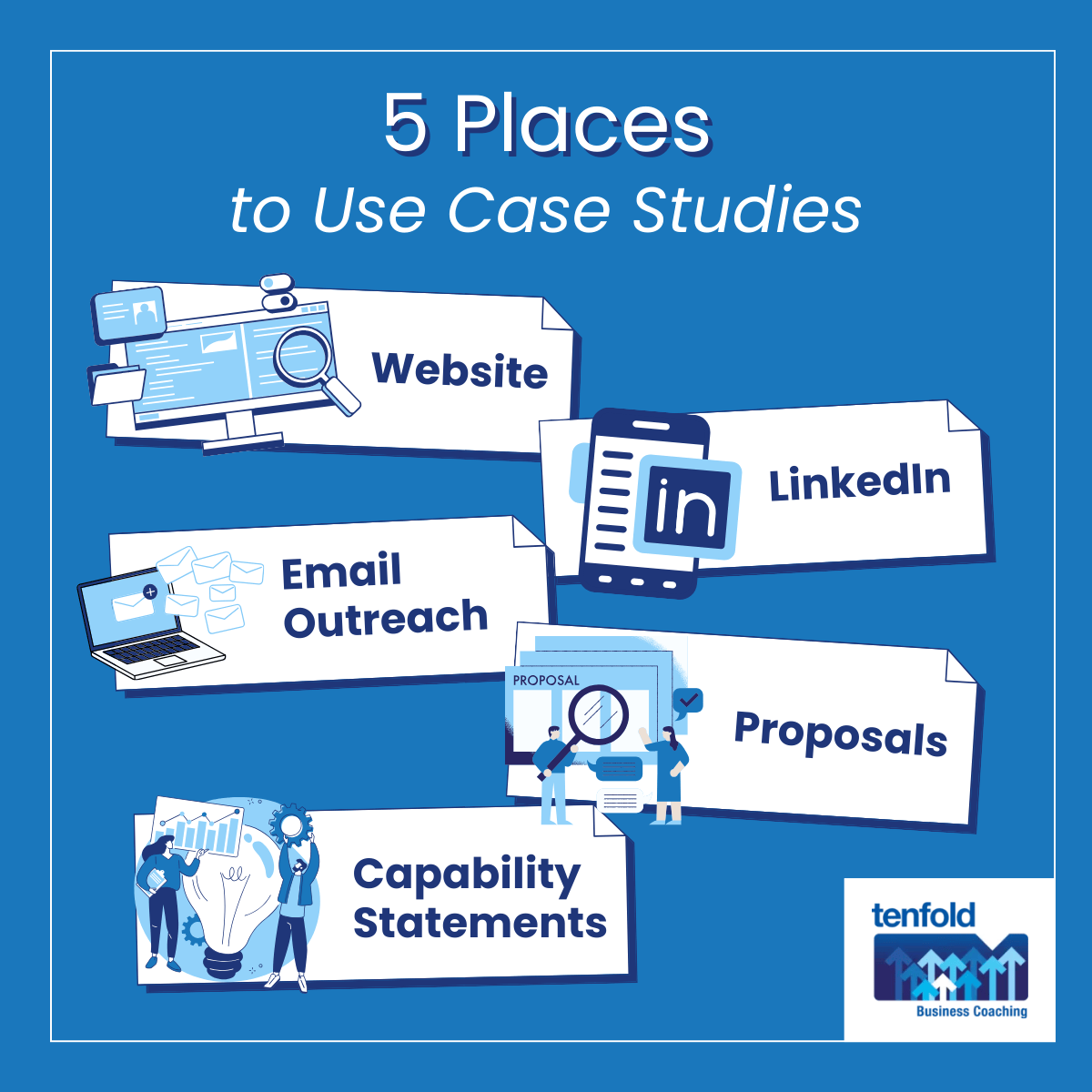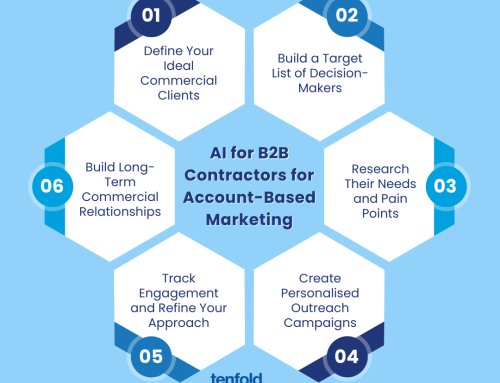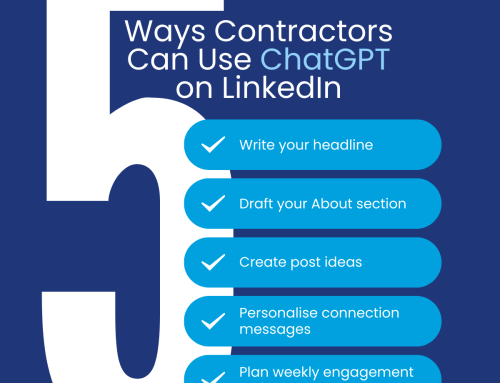AI for B2B Contractors to Win Work: Case Studies, Prompts, Workflows, Templates
For growing businesses in construction, manufacturing, and distribution, case studies are one of the most effective tools for winning better work. In my previous article, Case Studies for B2B Contractors to Win Work: Template, Examples, Checklist, I broke down how to create compelling case studies that attract Tier 2-3 commercial clients, REITs, and institutional buyers, without relying on paid advertising. This follow-up guide shows you how to use ChatGPT (free version only) to turn that advice into action. You’ll learn how to generate case study content, structure your stories, and use AI to support your B2B prospecting efforts.
I’m Ashley Thomson, a business coach at Tenfold Business Coaching. I work one-on-one with established, owner-operated businesses across Australia, helping them scale sustainably and profitably. My clients include builders, fabricators, wholesalers, and tradies with teams on payroll and annual revenue between $1M and $10M. With over a decade of experience in business coaching services, I’ve seen how the right tools (used the right way) can help business owners win better contracts and build stronger partnerships. This guide is designed to help you do just that, using ChatGPT as a practical assistant.
What Is a Case Study and Why It Works for B2B Prospecting
Case studies are real-world examples of how your business solved a problem for a client. They build trust by showing your process, your thinking, and your results. For B2B contractors, they’re especially powerful because commercial buyers want proof, not promises.
To use ChatGPT to start building your case studies, begin by summarising your recent projects. You can ask ChatGPT to help you shape the story, clarify your messaging, and highlight the outcomes.
Try These Prompts
Write a case study for a solar installation project we completed for a REIT-owned retail centre. Include the challenge, our solution, and the results.
Help me describe a fabrication job we did for a Tier 2 builder. The client needed custom steel frames delivered in under three weeks.
Create a case study summary for a plumbing contractor working on a multi-storey education facility. Focus on coordination with other trades and compliance outcomes.
Best Practices for Writing Case Studies That Win Work
Strong case studies start with a clear client challenge, followed by your solution and measurable results. They’re concise, specific, and tailored to your ideal audience. Visuals and client quotes add credibility, but the core of the story is your expertise.
ChatGPT can help you refine your writing, remove fluff, and maintain a professional tone. You can also use it to brainstorm ways to present your work more clearly.
Try These Prompts
Rewrite this case study to make it more concise and focused on outcomes. Here’s my draft: [paste your text]
What are three ways I can describe our approach to managing tight timelines on a commercial HVAC project?
Help me write a professional summary of our role in a landscape construction job for a Tier 2 builder. Include how we overcame site access issues.
What to Include in a Case Study
Every case study should include a project overview, the client’s challenge, your solution, the results, a client quote if available, visuals, and a call to action. These elements help commercial buyers understand your capabilities and build confidence in your business.
Use ChatGPT to draft each section individually. You can also ask for help formatting your case studies for your website or proposals.
Try These Prompts
Write a project overview for a wholesale distribution job we did for a national retailer. Focus on logistics and inventory management.
Generate a call to action for a case study about our work on a Tier 3 commercial solar installation. Encourage readers to contact us for similar projects.
Help me write a client challenge section for a builder who needed custom joinery delivered on a short timeline.
What Not to Do in a Case Study
Avoid vague language, jargon, and exaggeration. Case studies should be honest, specific, and written for your target audience. Focus on the client’s problem and your solution, not your company history.
ChatGPT can help you spot weak phrasing and suggest improvements. You can also use it to simplify technical language for non-specialist readers.
Try These Prompts
Review this case study and highlight any vague or generic statements. Here’s the text: [paste your draft]
Rewrite this paragraph to remove jargon and make it clearer for commercial property managers.
Make this case study sound more professional and less salesy. Focus on the facts and outcomes.
Using Case Studies for B2B Prospecting
Once your case studies are written, they can be used across your website, proposals, LinkedIn posts, and email outreach. They’re versatile tools that help you demonstrate capability and build trust with new clients.
ChatGPT can help you repurpose your case studies for different channels. You can also use it to draft outreach messages that reference relevant examples.
Try These Prompts
Write a LinkedIn post summarising our case study about a fabrication job for a Tier 2 builder. Keep it under 150 words.
Create an email introduction for a prospect in the education sector. Reference our case study about HVAC installation in a school.
Help me write a short paragraph for our website’s case study section. Introduce our work with REITs and Tier 3 commercial clients.
Case Study Template for B2B Contractors
A simple structure makes it easier to write and easier for clients to read. Start with the project name, client, challenge, solution, results, visuals, and a call to action.
ChatGPT can help you fill in each part of the template. You can also ask it to generate multiple versions so you can choose the one that fits best.
Try These Prompts
Fill in this case study template for a concreting job we did for a Tier 2 builder. Here are the details: [paste your notes]
Write three versions of the “results” section for a solar installation case study. Focus on performance and client satisfaction.
Create a case study using this structure: challenge, solution, results. The project was a plumbing upgrade for a manufacturing facility.
Example Case Study: Solar Installation for REIT-Owned Retail Centre
In the original article, I shared a case study about a solar installation project for a REIT-owned retail centre. The client needed a 100kW system installed across multiple rooftops with minimal disruption to tenants. Our team coordinated with property managers, staged installation over weekends, and delivered the project in 12 days with zero complaints.
You can use ChatGPT to generate similar examples based on your own projects. Just provide the key details and ask for a draft.
Try These Prompts
Write a case study similar to this solar installation example. The project was a commercial HVAC upgrade for a Tier 3 builder.
Create a case study for a fabrication job with tight deadlines and complex logistics. Include challenge, solution, and results.
Help me write a case study about a plumbing contractor working on a REIT-owned residential complex. Focus on compliance and coordination.
Final Thoughts from a Business Coach
Case studies are one of the most powerful tools for B2B contractors looking to grow. They build trust, demonstrate capability, and support long-term business development. As a small business coach, I’ve helped hundreds of owner-operated businesses use case studies to win better work. With ChatGPT, you now have a practical way to turn your experience into compelling stories, without needing a marketing team or paid ads.
If you haven’t read the original guide yet, I recommend starting there: Case Studies for B2B Contractors to Win Work: Template, Examples, Checklist. Then, come back to this article and use ChatGPT to put the advice into action. If you’d like help refining your strategy or building a repeatable workflow, Tenfold’s business coaching services are here to support you. Let’s make your next win easier to land.




![Account-Based Marketing (ABM) for Contractors: Connect with Facilities & Property Managers [Template, Examples, Checklist]](https://tenfoldcoaching.com.au/wp-content/uploads/2025/09/Account-Based-Marketing-ABM-for-Contractors-Connect-with-Facilities-Property-Managers-Template-Examples-Checklist-500x383.png)

